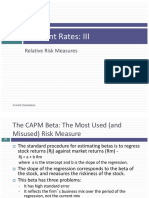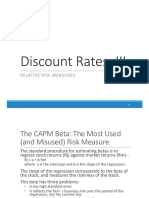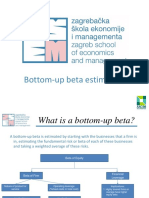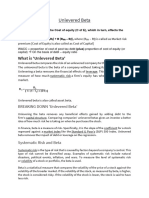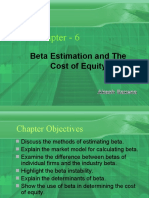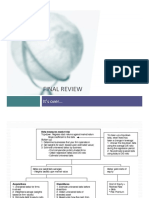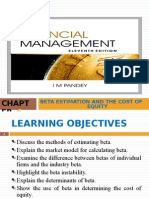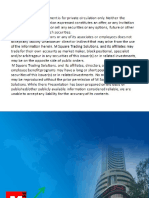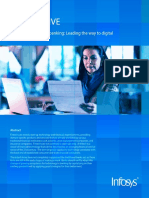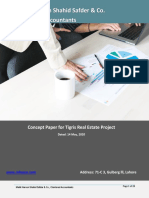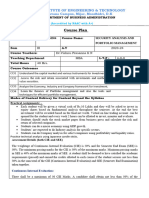The levered beta: Disney and its divisions
¨ To estimate the debt ratios for division, we allocate Disney’s total debt
($15,961 million) to its divisions based on identifiable assets.
¨ We use the allocated debt to compute D/E ratios and levered betas.
Business Unlevered beta Value of business D/E ratio Levered beta Cost of Equity
Media Networks 1.0313 $66,580 10.03% 1.0975 9.07%
Parks & Resorts 0.7024 $45,683 11.41% 0.7537 7.09%
Studio Entertainment 1.0993 $18,234 20.71% 1.2448 9.92%
Consumer Products 0.6752 $2,952 117.11% 1.1805 9.55%
Interactive 1.2187 $1,684 41.07% 1.5385 11.61%
Disney Operations 0.9239 $135,132 13.10% 1.0012 8.52%
Aswath Damodaran
178
� Discussion Issue
179
¨ Assume now that you are the CFO of Disney. The
head of the movie business has come to you with a
new big budget movie that he would like you to
fund. He claims that his analysis of the movie
indicates that it will generate a return on equity of
9.5%. Would you fund it?
¤ Yes. It is higher than the cost of equity for Disney as a
company
¤ No. It is lower than the cost of equity for the movie
business.
¤ What are the broader implications of your choice?
Aswath Damodaran
179
�Estimating Bottom Up Betas & Costs of
Equity: Vale
Sample' Unlevered'beta' Peer'Group' Value'of' Proportion'of'
Business' Sample' size' of'business' Revenues' EV/Sales' Business' Vale'
Global'firms'in'metals'&'
Metals'&' mining,'Market'cap>$1'
Mining' billion' 48' 0.86' $9,013' 1.97' $17,739' 16.65%'
Iron'Ore' Global'firms'in'iron'ore' 78' 0.83' $32,717' 2.48' $81,188' 76.20%'
Global'specialty'
Fertilizers' chemical'firms' 693' 0.99' $3,777' 1.52' $5,741' 5.39%'
Global'transportation'
Logistics' firms' 223' 0.75' $1,644' 1.14' $1,874' 1.76%'
Vale'
Operations' '' '' 0.8440' $47,151' '' $106,543' 100.00%'
Aswath Damodaran
180
�Vale: Cost of Equity Calculation – in
nominal $R
¨ To convert a discount rate in one currency to another, all you need are
expected inflation rates in the two currencies.
(1+ Inflation Rate Brazil )
(1+ $ Cost of Equity) −1
(1+ Inflation Rate US )
¨ From US $ to R$: If we use 2% as the inflation rate in US dollars and 9% as
the inflation
€
ratio in Brazil, we can convert Vale’s US dollar cost of equity
of 11.23% to a $R cost of equity:
¨ Alternatively, you can compute a cost of equity, starting with the $R
riskfree rate of 10.18%.
Cost of Equity in $R = = 10.18% + 1.15 (7.38%) = 18.67%
Aswath Damodaran
181
�Bottom up betas & Costs of Equity: Tata
Motors & Baidu
¨ Tata Motors: We estimated an unlevered beta of 0.8601
across 76 publicly traded automotive companies (globally)
and estimated a levered beta based on Tata Motor’s D/E ratio
of 41.41% and a marginal tax rate of 32.45% for India:
Levered Beta for Tata Motors = 0.8601 (1 + (1-.3245) (.4141)) = 1.1007
Cost of equity for Tata Motors (Rs) = 6.57% + 1.1007 (7.19%) = 14.49%
¨ Baidu: To estimate its beta, we looked at 42 global companies
that derive all or most of their revenues from online
advertising and estimated an unlevered beta of 1.30 for the
business. Incorporating Baidu’s current market debt to equity
ratio of 5.23% and the marginal tax rate for China of 25%, we
estimate Baidu’s current levered beta to be 1.3560.
Levered Beta for Baidu = 1.30 (1 + (1-.25) (.0523)) = 1.356
Cost of Equity for Baidu (Renmimbi) = 3.50% + 1.356 (6.94%) = 12.91%
Aswath Damodaran
182
�Bottom up Betas and Costs of Equity:
Deutsche Bank
¨ We break Deutsche Bank down into two businesses – commercial and
investment banking.
¨ We do not unlever or relever betas, because estimating debt and equity
for banks is an exercise in futility. Using a riskfree rate of 1.75% (Euro risk
free rate) and Deutsche’s ERP of 6.12%:
Aswath Damodaran
183
� Estimating Betas for Non-Traded Assets
184
¨ The conventional approaches of estimating betas
from regressions do not work for assets that are not
traded. There are no stock prices or historical returns
that can be used to compute regression betas.
¨ There are two ways in which betas can be estimated
for non-traded assets
¤ Using comparable firms
¤ Using accounting earnings
Aswath Damodaran
184
�Using comparable firms to estimate beta
for Bookscape
Unlevered beta for book company = 0.8130/ (1+ (1-.4) (.2141)) = 0.7205
Aswath Damodaran Unlevered beta for book business = 0.7205/(1-.05) = 0.7584 185
�Estimating Bookscape Levered Beta and
Cost of Equity
¨ Because the debt/equity ratios used in computing
levered betas are market debt equity ratios, and the only
debt equity ratio we can compute for Bookscape is a
book value debt equity ratio, we have assumed that
Bookscape is close to the book industry median market
debt to equity ratio of 21.41 percent.
¨ Using a marginal tax rate of 40 percent for Bookscape,
we get a levered beta of 0.8558.
Levered beta for Bookscape = 0.7584[1 + (1 – 0.40) (0.2141)] = 0.8558
¨ Using a riskfree rate of 2.75% (US treasury bond rate)
and an equity risk premium of 5.5%:
Cost of Equity = 2.75%+ 0.8558 (5.5%) = 7.46%
Aswath Damodaran
186
�Is Beta an Adequate Measure of Risk for a
Private Firm?
¨ Beta measures the risk added on to a diversified
portfolio. The owners of most private firms are not
diversified. Therefore, using beta to arrive at a cost
of equity for a private firm will
a. Under estimate the cost of equity for the private firm
b. Over estimate the cost of equity for the private firm
c. Could under or over estimate the cost of equity for the
private firm
Aswath Damodaran
187
�Total Risk versus Market Risk
¨ Adjust the beta to reflect total risk rather than market risk.
This adjustment is a relatively simple one, since the R squared
of the regression measures the proportion of the risk that is
market risk.
¤ Total Beta = Market Beta / Correlation of the sector with the market
¨ In the Bookscape example, where the market beta is 0.8558
and the median R-squared of the comparable publicly traded
firms is 26.00%; the correlation with the market is 50.99%.
Market Beta 0.8558
= = 1.6783
R squared .5099
¤ Total Cost of Equity = 2.75 + 1.6783 (5.5%) = 11.98%
Aswath Damodaran
188





